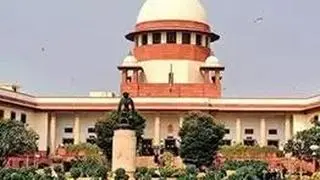The ghost of casteism, believed long buried under the layered carpets of secularism, Hindutva and vikas (development) over the last few decades, has returned to haunt the main contenders, BJP and the Congress, who face the first caste-centric elections after 1985 to the Gujarat Vidhan Sabha.
The last caste-based Assembly election fought by the Congress was under the stewardship of its then veteran leader, Chief Minister Madhavsinh Solanki, who had cobbled together a formidable combination of the Kshatriyas-Harijans-Adivasis-Muslims (KHAM) to reap rich dividends in 1985, when his party swept 149 seats out of 182 in the Assembly. Unlike in other states, a large number of Kshatriyas-Rajputs-Thakores in Gujarat count themselves among the “backwards”. The 1985 poll cost the Congress its age-old all-caste-umbrella status. In 1992, at Ayodhya, it also lost its “secular” tag and, in Gujarat, it came to be perceived as a party of tribals and Muslims — the Kshatriyas and the Harijans being now enrolled by Hindutva!
The VP Singh Government’s 1990 implementation of the Mandal Commission’s Recommendations granting reservation to the OBCs, intensified tensions amongst the various castes, as in other states, too. The Sangh Pariwar’s saffron experiment, however, slowly pushed it under the carpet of Hindutva, making the BJP form its first Government, led by Keshubhai Patel, in 1995. After the 2002 Godhra-triggered communal riots, Narendra Modi emerged as the Hindu Hriday Samrat, but he quickly pushed both casteism and Hindutva under the new hold-all carpet, vikas, if only to get even with his intra-Sangh Pariwar detractors.
Until he helmed Gujarat, his multiple vikas projects, showcased by the Vibrant Gujarat events, successfully camouflaged the socio-economic realities, with huge posters literally screening off slum areas in the cities, including Ahmedabad and Gandhinagar. While the biennial International Investors’ Summits promised lakhs of crores worth of investments, less than 10 per cent of this actually got implemented.
The high hopes of development with jobs he generated by sowing the seeds of runaway privatisation, agricultural lands-turning-into SEZs and industries, had begun to evaporate by the 2008 global slowdown, but he managed to keep up the show. The farmers’ land was now owned at many places by land sharks and their children were pushed into the labour class. Amid this socio-economic churning, Modi''s move to New Delhi as PM in 2014, left his successors, Anandiben Patel and Vijay Rupani, to reap the whirlwinds — Hardik Patel, Alpesh Thakore, Jignesh Mewani.
By August 2017, even vikas has become somewhat of a millstone around its promoter, the BJP’s neck! The party, bereft of any new poll plank, now has only the TINA (There Is No Alternative) factor to fall back upon.
Casteism in bloom
With these multiple whammies, Gujarat politics has witnessed the return of casteism in full flowering as caste groups take out rallies each day. Both Modi and Congress Vice-President Rahul Gandhi have tried to recreate some magic out of their ‘newfound’ love of Hinduism, as they have visited Hindu shrines in recent weeks, while they struggle to coin a one-slogan-fits-all in a state that has largely seen a bipolar polity over the last few decades. On their home ground, Modi and his Man Friday, BJP President Amit Shah, find themselves trying to blow out the latent fires they believed they had extinguished.
According to the projections based on the last caste-based Census of Gujarat (1931), the OBCs comprised nearly 40 per cent of the state’s population, mainly the Thakores and the Kolis. Modi belongs to this group after his caste was included among the OBCs in the 1990s. And Hardik Patel is demanding that the Patidars (12 per cent) be included in this list, something opposed tooth-and-nail by Alpesh Thakore. That is why neither the BJP nor the Congress will find it easy to accede to the Patidars’ demand.
In 2012, Keshubhai Patel had floated the Gujarat Parivartan Party (GPP), largely a Patidar outfit, which won 3.7 per cent of the votes and only two Assembly seats but damaged the Congress in over a dozen other seats by splitting anti-BJP votes, and helping the BJP gain. Any similar attempt by Hardik's supporters is expected to be ‘welcomed’ by the BJP!
The Patidars are believed to be in large numbers in 52 Assembly constituencies, while the Thakores and Kolis are said to be decisive voters in 68 constituences. Clearly, no political party can afford to ignore either of them.
The tribal areas of Gujarat, with 15 per cent of the state’s population, have largely been the Congress’ bastion, while Muslims (10 per cent) have mostly supported the Congress and the Janata Dals.
The Dalits (8 per cent), Rajputs (5 per cent), Brahmins and Vaishyas (2 per cent each) and Jains and the rest (1 per cent each) are the other major castes of Gujarat. Of these, the Dalits, Rajputs and Brahmins have been agitating against the BJP government on various issues, including atrocities and reservations. The current CM Vijay Rupani, a Jain, has not been successful in inspiring confidence among the various castes about the BJP being a hold-all party.
From Mandal and Mandir, Gujarat has returned to the basics of casteism as it faces the next Assembly elections on December 9 and 14 to elect the 14th Vidhan Sabha.








Comments
Comments have to be in English, and in full sentences. They cannot be abusive or personal. Please abide by our community guidelines for posting your comments.
We have migrated to a new commenting platform. If you are already a registered user of TheHindu Businessline and logged in, you may continue to engage with our articles. If you do not have an account please register and login to post comments. Users can access their older comments by logging into their accounts on Vuukle.